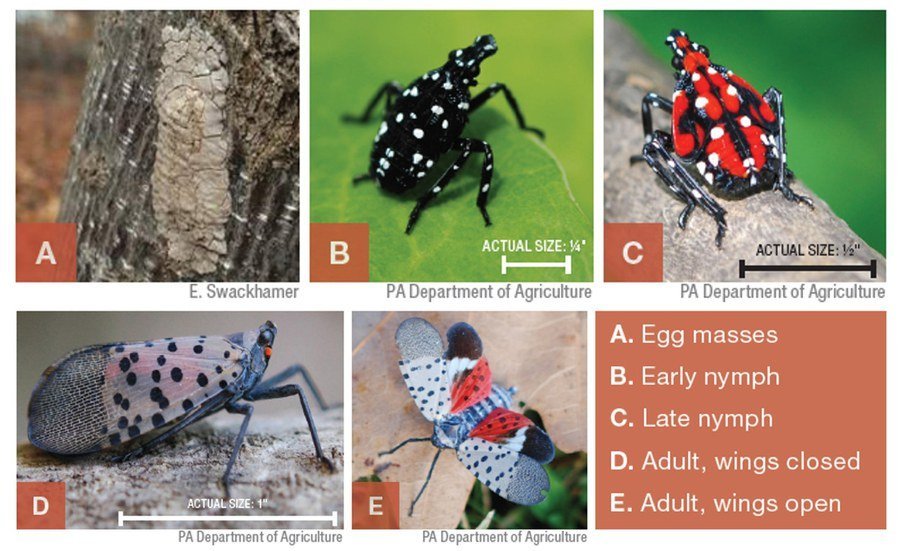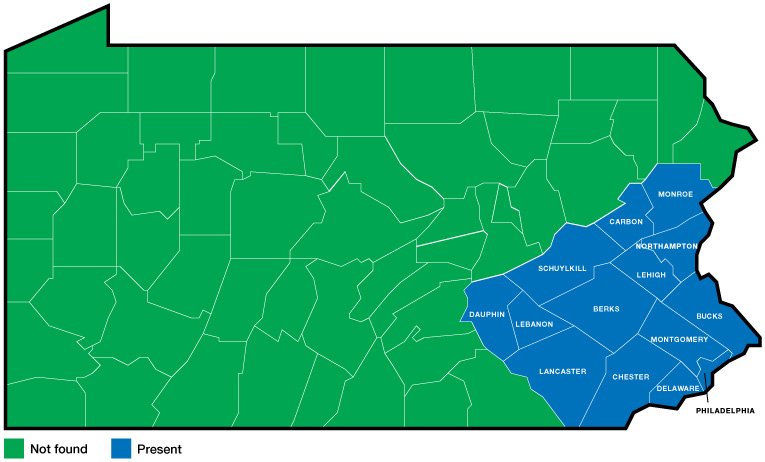NEWS!
Study at Penn State to examine potential for birds to eat spotted lanternfly
Do birds find the spotted lanternfly to be a tasty treat or a nauseating nibble? That is one of the questions researchers at Penn State hope to answer, and they are seeking citizen scientists, especially bird watchers, to help in their quest for knowledge. Click here for more information.
New Style Spotted Lanternfly Circle Trap
The Penn State Extension has recently released information on a new and efficient way to trap Spotted Lanternflies.
This new style trap is made of plastic-coated insect screening and does not use any sticky material at all.
Click here for details or visit the Penn State Extension website by clicking here.
Deciding If and When to Treat for Spotted Lanternfly or Ornamentals
Spotted lanternfly nymphs and adults are both fairly easy to kill with insecticides; even the less toxic insecticides like soaps and oils can work well. That said, there are many things to consider before deciding to use an insecticide to kill spotted lanternfly on landscape trees or shrubs. Click here for more information.
Spotted Lanternfly Checklist for Residents
A printable checklist developed by Penn State Extension and the state Department of Agriculture can help citizens prevent the spread of the spotted lanternfly. Click here to get started.
The following information has been provided to the Township from The Penn State Extension and PA Township News
WHAT IS IT?
The Spotted Lanternfly (SLF), Lycorma Delicatula, is a destructive invasive plant, native to China, that was first detected in 2014 in southeastern Pennslyvania. It feeds voraciously on many plants, including economically important crops like fruit trees, grapevines, hops, hardwoods, and ornamentals. The Spotted Lanternfly's favored host, however, is the Tree-of-Heaven.
IDENTIFICATION
There is one generation of SLF per year. The eggs are laid in late fall and hatch in the spring. Egg masses are laid on hard surfaces (trees, decks, houses, outdoor equipment, rocks, etc), and protected with a mud-like covering. See the life stages below and click the photo for more information on identification.

MANAGEMENT & QUARANTINE
Fall, Winter, and Spring
Destroy egg masses
Check for egg masses on trees, cement blocks, rocks, and any other hard surfaces. If you find egg masses, scrape them off using a plastic card or putty knife and then place the masses into a bag or container filled with rubbing alcohol or hand sanitizer. This is the most effective way to kill the eggs, but they can also be smashed or burned.
Spring and Summer
Band trees
When the nymphs first hatch, they will walk up the trees to feed on the softer, new growth of the plant. Take advantage of this behavior by wrapping tree trunks in sticky tape and trapping the nymphs. Check the traps on a regular basis because, while rare, birds and small mammals can become stuck to the tape.
Remove tree-of-heaven
While the spotted lanternfly will feast on a variety of plant species, they have a special fondness for Ailanthus, or tree-of-heaven, which is an invasive plant that is common in landscape plantings, agricultural areas, and along the sides of roads. For this reason, there is a current push from spotted lanternfly experts to remove this tree.
Spring, Summer, and Fall
Use insecticides
When used appropriately, insecticides can be a very effective and safe way to reduce lanternfly populations. The Penn State Extension is currently researching which insecticides are best for controlling the pest, but preliminary results show insecticides with the active ingredients dinotefuran, imidacloprid, carbaryl, and bifenthrin are most effective.
However, there are safety, environmental, and sometimes regulatory concerns that go along with the use of insecticides, so the Extension advises homeowners to do research, weigh the pros and cons, and seek professional advice if needed.
All Year
Stop the spread
To help stop the insect's spread, check your vehicle closely- undercarriages, windshield wipers, wheel wells, luggage racks, and such - for spotted lanternflies and egg masses before traveling in and out of the quarantine zone.
The graphic below shows which counties are included in the quarantine. You can help stop the spread by checking your car and outdoor equipment (grills, outdoor furniture, landscaping supplies, mowers, etc.).
Questions can be directed to the Spotted Lanternfly Hotline at 1-888-422-3359.
